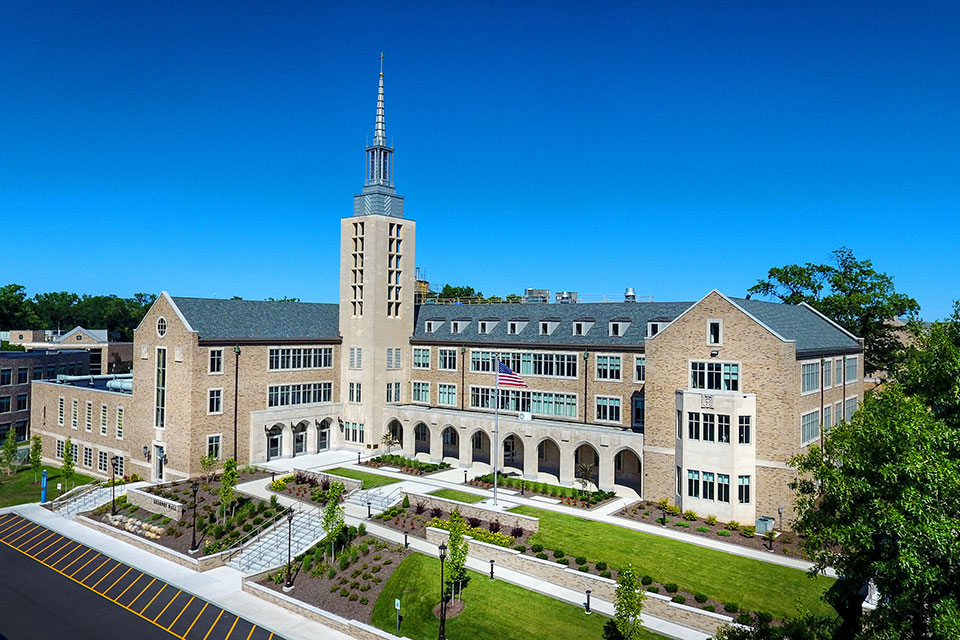Report: Fisher’s Regional Impact is Strong and Growing
The economic and civic impact of St. John Fisher University is strong and projected to grow, according to the 2023 Economic and Community Impact Report, an economic impact study conducted by Appleseed, a New York City-based economic consulting firm.
The firm’s forecasted outlook is the result of continued growth in the number of Fisher alumni living and working in the Rochester area (and elsewhere in New York), new curricular developments that prepare graduates for careers in rapidly growing fields, expanded online program offerings, and Fisher’s position as an anchor institution and involvement in collective efforts to address community needs. The findings of the study—which examined the University as an enterprise, its development of human capital, its civic and community engagement, and its growing impact in the Rochester area and beyond—have been made available online.
“Throughout our 75-year history, Fisher has taken the lead in educating the region’s workforce and generating positive economic and community impact locally, nationally, and increasingly, globally,” said Dr. Gerard J. Rooney, president of the University. “Our strategic growth – in terms of enrollment, programmatic offerings, and campus footprint – have enhanced our capacity to fulfill our mission and meet the evolving needs of the broader community.”
In fall 2022, Fisher employed nearly 900 people (an increase of 35 percent over the last two decades) with wages paid to employees totaled $49.4 million. Nearly 95 percent of University employees lived in the Rochester area. In the same time period, 367 Fisher students earned wages totaling $1.1 million in part-time positions with the University.
The study estimated that Fisher generated $135.6 million in regional economic output in fiscal year 2023. This was produced by the direct, indirect, and induced effects of Fisher’s spending on payroll, purchasing and construction, and off-campus spending by students and by visitors. The study also found that Fisher directly accounted for 1,427 jobs in Rochester, with earnings totaling nearly $79.4 million.
In addition, the University has played a vital role in educating the next generation of the region’s workforce. In fall 2022, 3,621 students were enrolled at Fisher – an increase of 2.8 percent since fall 2005. Nearly 93 percent of those students were New York state residents, including nearly 50 percent who were residents of the Rochester area.
Fisher students also choose to remain in the Rochester area. Of the 78 percent of Fisher alumni who live in New York state, 57 percent have chosen to live and work in Rochester. In fact, nearly 7 percent of Rochester-area residents aged 25+ have a bachelor’s degree from the University.
Additionally, in fall 2022, Fisher provided nearly $44.8 million in University-funded financial aid and endowed scholarships to undergraduate students ($20.3 million to students from the Rochester area). Student financial support has been increasing as a result of the University’s growing endowment, increasing number of endowed scholarships, and its ongoing commitment to making a Fisher education affordable.
Community service and civic engagement have been at the heart of St. John Fisher University since its founding and the institution continues to attract students who demonstrate a strong commitment to that mission. During the 2022-23 academic year, 2,654 Fisher students spent a combined total of 446,238 hours working as volunteers in a wide range of community service programs in the Rochester area. Fisher employees also lived out that mission beyond their workday as they reported volunteering an estimated 24,000 hours in the 2022-2023 year.
The study detailed the substantial professional and civic impact Fisher alumni make in the greater Rochester region, finding that 33,146 of Fisher’s living alumni, or 57 percent, live in the area (22 percent living elsewhere in New York state). The study also noted that Fisher’s graduates are especially well represented among the region’s “well-educated 25-to-45-year-old workers so critical to the vitality and adaptability of New York’s economy.” That figure is predicted to grow as the University continues to enroll more than 1,000 students each year.
